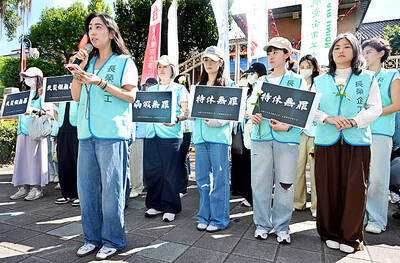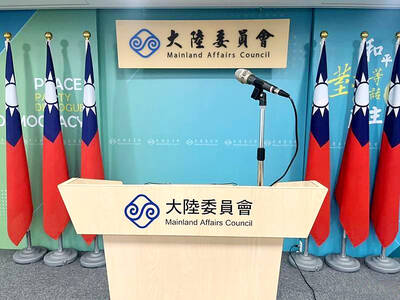A shipment of Taiwanese rice bound for Tokyo departed central Taiwan yesterday, the second in a series of three deliveries of the biggest rice order received from Japan in eight years.
A ceremony was held in Changhua County’s Pitou Township (埤頭), where the rice supplier, Union Rice Co, is based, to mark the shipment and the success of Changhua rice in entering Japan’s market.
The rice is being delivered to major Japanese rice importer Kitoku Shinryo Co, which ordered 360 tonnes earlier this year, the largest purchase of rice since exports to Japan were resumed in October 2004.
The rice will be distributed directly to Japanese retailers, the first time Taiwanese rice will be sold to Japanese consumers. In the past, it was mostly sold to wholesalers supplying restaurants or food processors.
Agriculture and Food Agency Director Li Tsang-lang (李蒼郎) said rice exports have long been constrained by high costs of production, which make Taiwanese rice more expensive than that grown in the US, Thailand and Australia.
Kitoku Shinryo decided to place an order due to the high quality of Taiwan’s rice, he said.
“After the rice passed all tests, they placed an order with us. The success represents positive recognition of the quality of Taiwanese rice and the technology used to process it,” Li said.
The Council of Agriculture said rice exported to Japan must pass 591 pesticide residue tests before being given the green light.
Makoto Hirayama, president of Kitoku Shinryo Co, visited Taiwan last month to inspect paddy fields, barns and processing plants and tasted the rice himself before placing the order.
The order has been partly motivated by the food shortages faced in Japan recently. Radiation contamination of farms from the damaged Fukushima Dai-ichi nuclear power plant and flooding in Niigata, a famous rice production district, have combined to limit Japan’s food output, the council said.
The council was confident that Japanese importers would continue to order rice from Taiwan even after the shortages pass because of the high quality of Taiwanese rice.
Yesterday’s shipment, like the first one, weighed 108 tonnes, with the rice packed in 30kg bags. Upon arrival in Tokyo it was to be repacked before being distributed.

A drunk woman was sexually assaulted inside a crowded concourse of Taipei Railway Station on Thursday last week before a foreign tourist notified police, leading to calls for better education on bystander intervention and review of security infrastructure. The man, surnamed Chiu (邱), was taken into custody on charges of sexual assault, taking advantage of the woman’s condition and public indecency. Police discovered that Chiu was a fugitive with prior convictions for vehicle theft. He has been taken into custody and is to complete his unserved six-month sentence, police said. On Thursday last week, Chiu was seen wearing a white

The Taoyuan Flight Attendants’ Union yesterday vowed to protest at the EVA Air Marathon on Sunday next week should EVA Airway Corp’s management continue to ignore the union’s petition to change rules on employees’ leave of absence system, after a flight attendant reportedly died after working on a long-haul flight while ill. The case has generated public discussion over whether taking personal or sick leave should affect a worker’s performance review. Several union members yesterday protested at the Legislative Yuan, holding white flowers and placards, while shouting: “Life is priceless; requesting leave is not a crime.” “The union is scheduled to meet with

‘UNITED FRONT’ RHETORIC: China’s TAO also plans to hold weekly, instead of biweekly, news conferences because it wants to control the cross-strait discourse, an expert said China’s plan to expand its single-entry visa-on-arrival service to Taiwanese would be of limited interest to Taiwanese and is a feeble attempt by Chinese administrators to demonstrate that they are doing something, the Mainland Affairs Council said yesterday. China’s Taiwan Affairs Office (TAO) spokesman Chen Binhua (陳斌華) said the program aims to facilitate travel to China for Taiwanese compatriots, regardless of whether they are arriving via direct flights or are entering mainland China through Hong Kong, Macau or other countries, and they would be able to apply for a single-entry visa-on-arrival at all eligible entry points in China. The policy aims

The government yesterday donated US$200,000 to the Philippines to support post-earthquake relief and recovery efforts, following a powerful magnitude 6.9 quake that struck Cebu Province late last month, killing at least 72 people and injuring 559 others. The donation was presented earlier yesterday by Representative to the Philippines Wallace Chow (周民淦) to Cherbett Maralit, deputy resident representative of the Manila Economic and Cultural Office, at Taiwan’s representative office in Manila. In his remarks, Chow expressed concern for those affected by the magnitude 6.9 earthquake that struck the central Philippines on the night of Sept. 30. "We sincerely hope for the earliest possible